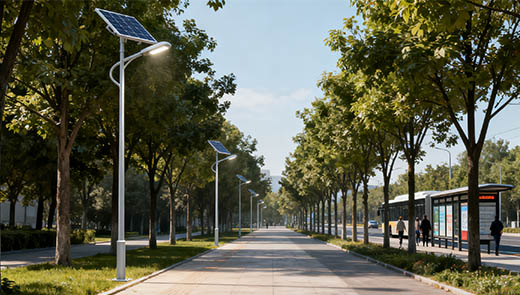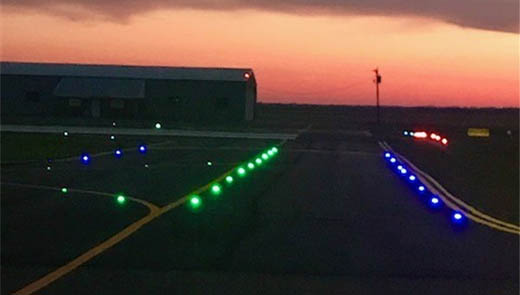Solar-Powered Street Lighting: Benefits And Challenges
Under the wave of energy transition and sustainable development, the innovation of urban lighting system is urgent. Solar-powered street lighting, as a typical representative of green energy application, has gradually become an important choice for modern urban lighting due to its unique advantages. However, this technology is also facing many challenges in the process of popularizing and applying. An in-depth investigation of the benefits and challenges of solar street lighting is of great significance to promote its further development.
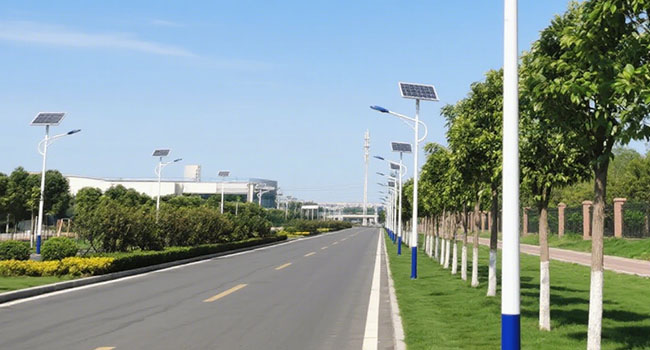
What is Solar-Powered Street Lighting?
Basic Principle
Solar street light is an outdoor lighting system that uses photovoltaic (PV) panels to collect solar energy and convert it into electricity. The photovoltaic panels absorb sunlight during the day and convert solar energy into electricity through the photovoltaic effect. Part of this electricity is supplied directly to the lighting fixtures, while the remaining part is stored in batteries for use at night or when there is insufficient light.
Solar Panel
Solar panel is the core component of solar street light, undertaking the key task of energy conversion. The common solar panels on the market today are mainly monocrystalline silicon and polycrystalline silicon types. Monocrystalline silicon solar panels have a higher conversion efficiency, usually up to 20%-25%, while polycrystalline silicon solar panels generally have a conversion efficiency of 15%-20%.
|
Type of Solar Panel |
Conversion Efficiency Range |
Features |
|
Monocrystalline Solar Panel |
20% - 25% |
Higher conversion efficiency, relatively higher cost than polycrystalline |
|
Polycrystalline Solar Panel |
15% - 20% |
Relatively lower cost, slightly lower conversion efficiency than monocrystalline |
Lighting Fixtures
Most modern solar street lights utilize LEDs as a light source, which has significant advantages over traditional High Pressure Sodium (HPS) lamps. LED lamps offer significant advantages over traditional High Pressure Sodium (HPS) lamps; LED lamps consume at least 50% less energy than HPS lamps and provide higher lumens with lower energy consumption, while LED lamps require no warm-up time and can be used in conjunction with motion detectors to further increase energy savings.
Rechargeable Battery
The battery stores the electricity generated by the solar panels during the day and powers the light at night. The life of the battery directly affects the overall life of the streetlight, and its capacity determines the number of days the streetlight can be on standby. Common battery types include gel deep-cycle batteries and lead-acid batteries, etc. Different types of batteries differ in performance, life and cost.
Controller
Controllers play a regulatory role in solar street light systems and are responsible for controlling the charging and lighting switches. Some modern intelligent controllers support programming function, users can set charging, lighting and dimming parameters according to the actual demand, to realize intelligent management.
Light Pole
Sturdy light pole is an important support for solar LED street light. Since the lamps, solar panels and even some batteries of solar street lights will be installed on the top of the pole, the strength and stability of the pole are required to be high. In some new designs, the photovoltaic panels and electronic components are integrated inside the pole, and the wind resistance of the pole is also taken into account in the design.
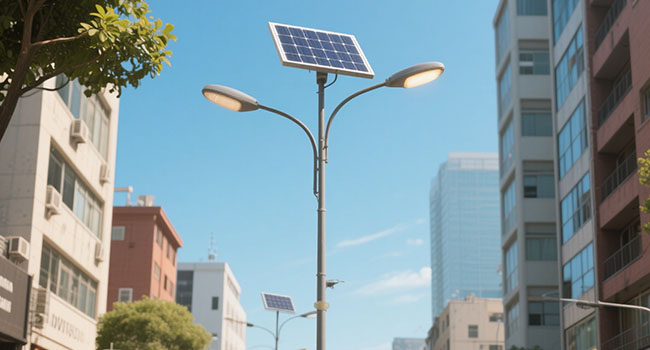
Benefits of Solar-Powered Street Lighting
Energy Efficiency and Cost Savings
Solar-powered street lighting is excellent in terms of energy efficiency. Standard LED lamps, for example, use up to 80% less energy than traditional high-pressure sodium lamps. This means that municipalities and businesses that utilize solar street lights can significantly reduce their electricity bills. In many areas with tight power supplies, solar street lights are a reliable lighting option, eliminating the need to rely on unstable grid power and relieving pressure on the electricity supply.
Environmental Impact
Zero-emission operation: Solar street lights do not produce any pollutant emissions during operation, in contrast to traditional street lights that rely on coal-fired power generation, which contributes to the goal of carbon neutrality.
Reduced Waste: LED lamps have a lifespan of up to 50,000 hours, far longer than traditional light bulbs. This results in far fewer lamp replacements and reduces the environmental burden of producing and disposing of discarded bulbs.
Reduced Light Pollution: LED solar street lights can be reasonably designed to accurately project light to the area that needs to be illuminated, which greatly reduces light pollution and protects the ecological environment and nighttime astronomical observation conditions compared to traditional street lights.
Enhanced Public Safety
Good nighttime lighting is the key to public safety, and LED lights have excellent color rendering and uniform light distribution, providing pedestrians and drivers with a clear view of the road and significantly reducing the probability of traffic accidents at night. In addition, in the event of power outages and other emergencies, solar street lights can still continue to illuminate and ensure street safety thanks to their independent power supply system. This feature is especially important in areas prone to natural disasters or remote areas with unstable power supply.
Rural Electrification and Development
In rural areas, the use of solar street lights breaks the limitations of nighttime activities. In the past, learning, business and social activities in rural areas were often forced to stop after nightfall. With solar street lights, children can study at night, businesses can extend their hours of operation, and villagers can engage in more evening social activities, thereby contributing to the economic development and social progress of rural areas.
Smart Technology Integration
Today's solar street lights have been integrated with smart technology, becoming an important part of smart city construction. Some of the solar street lights have smart dimming function, which can automatically adjust the brightness according to the presence of pedestrians and vehicles, further saving energy. In addition, the built-in sensors can collect real-time data on air quality, noise level, traffic flow, etc., providing powerful data support for urban planning and management.
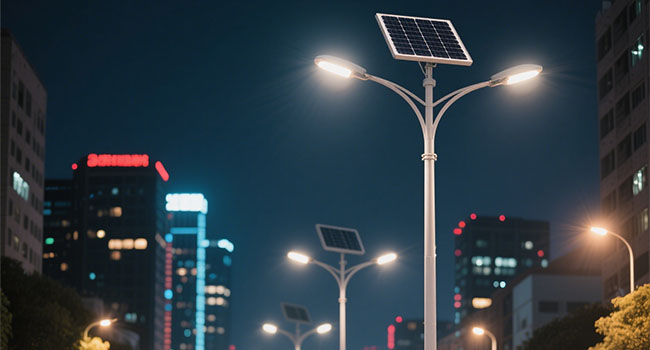
Challenges of Solar-Powered Street Lighting
Initial Investment: The Price of Progress
While solar street lights can provide significant cost savings over the long term, the high upfront cost of purchase and installation is a major deterrent for many communities and businesses with limited budgets. To address this issue, financing models such as government subsidies, green finance loans, and public-private partnerships can be actively explored to lower the initial investment threshold and promote the popularization of solar street lights.
Sunlight Availability: Navigating Shadows
The working efficiency of solar street lights is highly dependent on sunlight. In areas with short sunlight hours and frequent cloudy weather, the power generation of solar panels will be affected, which in turn affects the lighting effect of street lights. To address this challenge, measures such as increasing the battery storage capacity and optimizing the installation location of the streetlight to capture more light can be used to ensure the streetlight's normal operation under low light conditions.
Battery Limitations: Powering Through Limits
As the energy storage core of solar street light, battery has the problem of limited service life. With the increase of charging and discharging times, the battery performance will gradually decline and need to be replaced periodically, which undoubtedly increases the maintenance cost and management difficulty of street lights. At the same time, the differences in performance and cost of different types of batteries also require users to make comprehensive considerations when choosing.
Light Pollution: Overcoming Obstacles
Light pollution can also occur if solar street lights are installed in the wrong location or if the brightness is set too high. This not only interferes with the normal activities of wildlife at night, but also adversely affects astronomical observations. Therefore, when designing and installing solar street lights, the problem of light pollution needs to be taken into account, and light leakage should be minimized through rational planning and the use of shading devices.
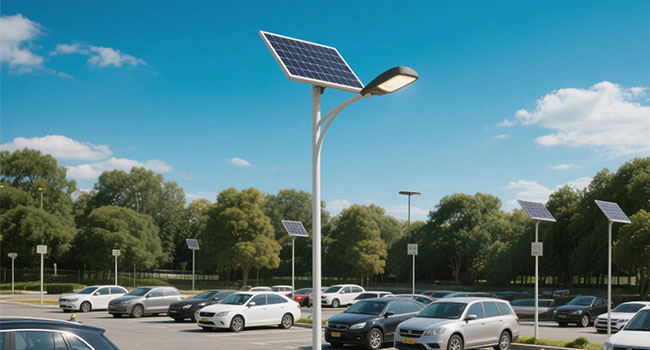
The Future of Solar-Powered Street Lighting
Technological Innovation
Technological innovation is the driving force behind solar technology. The application of new chalcogenide materials and nanotechnology greatly improves the conversion efficiency of solar panels, and the theoretical efficiency breakthrough of 30% is no longer far away; thin-film batteries and other new processes make the products thinner, lighter and more flexible, and can be widely used in curved buildings and transportation surfaces. Meanwhile, intelligent tracking technology enables solar panels to adjust the angle in real time to maximize the absorption of light energy. These innovations have made the solar street lights more efficient in power generation and more stable in performance, and have built a strong technological foundation for their wide application around the world.
Smart Integration
The Internet of Things and smart sensors are deeply integrated into the solar street light. Various types of sensors collect real-time environmental data such as light, temperature, and human flow, which are analyzed in the cloud to realize intelligent dimming, so that “people come to light and people go to dark”; big data and AI algorithms help predictive maintenance, warn of failures in advance, and reduce operation and maintenance costs. In addition, solar street lights can also be linked with urban transportation and security systems to respond in a timely manner to traffic accidents and abnormal situations. By linking with multiple systems in the city, the street light becomes an intelligent node of the smart city.
Sustainable Design
The concept of sustainable design dominates urban planning, and solar street lights are deeply integrated with the urban landscape. In terms of modeling, combined with regional cultural characteristics, traditional elements are integrated into historical neighborhoods, and bionic design is adopted in ecological parks; in terms of layout, the spacing and light angle are scientifically planned to reduce light pollution and take care of the nighttime ecology of plants and animals. In addition, the street lamps are made of recyclable materials to minimize the impact of the whole life cycle on the environment. street lights are no longer just lighting tools, but also green facilities that beautify the city and protect the ecology.
Policy Support
Governments are pushing for renewable energy policies. In terms of financial subsidies, they not only give support according to the proportion of project investment, but also give extra tilt to projects in rural and remote areas; tax incentives cover the whole chain of research and development, production and sales to stimulate the vitality of enterprise innovation; mandatory standards require that new areas prioritize the use of solar street lamps, and regularly update the technical indicators. Driven by policies, solar street light industry attracts a lot of investment, accelerates technological innovation and market expansion, and forms a benign development cycle.
Community Engagement
Public awareness of environmental protection has awakened, and they actively support solar street light projects. Residents are deeply involved in the planning, expressing their needs through hearings and online platforms; during the installation phase, volunteers help coordinate and supervise the construction. Communities also conducted environmental classes and parent-child experience activities to popularize solar energy knowledge. Some communities have established point reward mechanisms to encourage residents to participate in the daily inspection and maintenance of street lights. The active participation of the community creates a favorable atmosphere to promote the green transformation of urban lighting.
Solar street lights have shown great potential for development due to their significant advantages in energy efficiency, environmental protection, public safety and other aspects. Despite the challenges of high initial investment, sunlight dependence, battery limitation and light pollution in the promotion process, with the advancement of technology, policy support and public awareness, solar street lights will certainly play a more important role in the future construction of urban lighting and rural electrification, contributing to the realization of sustainable development goals.


